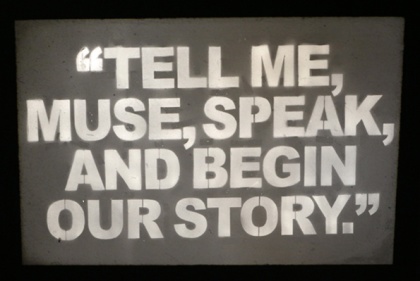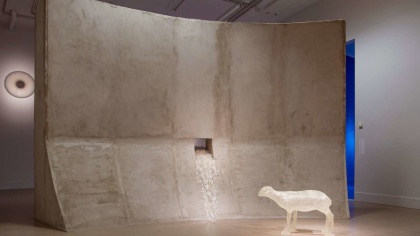THE ARTIST NEDA SAEEDI
From Teheran to KKV
When. September-October 2018
Where. KKV in Luleå
Who. Neda Saeedi (b. 1987) is an Iranian artist who currently lives between Tehran and Berlin - where she studied sculpture (Kargah Honar, Tehran) and Fine Arts (UdK Berlin). During her residency at KKV she produced a work that will be exhibited at Ájtte museum in Jokkmokk as part of the Luleå Biennial (17th November 2018 - 17th February 2019)
Organizers. KKV Luleå and Luleå Biennial in collaboration with ArtNorth and Region Norrbotten

Neda Saeedi, Garden of Eden Moving: A Petrified Tribe (2018, Jokkmokk)
A massive wall stands in the way of the visitor. An animation of a herd of sheep wading through a pond only to be relentlessly swallowed into its depths is projected on to its concrete surface. Neda Saeedi’s Garden of Eden Moving: A Petrified Tribe looks at events of modern history in relation to the Bachtiaris tribe, and the how its nomadic culture and way of life dramatically changed when the Iranian state elected to contain them within the boundaries of Shooshtar-e Noe. The town was constructed around the industrial production of sugar with fields of sugarcane planted directly adjacent to it. This is where other local people, as well as the nomads residing throughout the region, were to work.
The establishment of this town was part of the Shah of Iran, Mohammad Reza Pahlavis’s, 1963 modernisation reforms known as ‘the White Revolution’. The reforms included the industrialisation of the countryside, as well as an attempt to ‘civilise’ the nomadic groups – otherwise in constant motion – independent of state institutions. The way of life and social structures used to be determined by the livestock, the sheep – the animals that provided food, and, vitally, milk, but also materials for clothes and other artefacts.
In the last decades, the sugar factory has been leaking toxic waste, with the result that one of Iran’s primary wetlands now is something more like a waste- land. Desertification, extinction of species and more frequent sandstorms are among the consequences.

Saeedi works with highly symbolic materials. Control, the significance of the cattle and the double nature of the sugar are all central to the work, which touches equally on issues of pollution and ecology, and the formal aspects of architectures of confinement. The figures, made out of candied sugar, recall its addictive sweetness, but also its significance
in relation to deforestation and colonialism. In an audio component of the work, we hear a personal saga reminiscing about the cycles of nomadic life: “For us, migration was life. Reproduction. Movement was survival. No beginning, nor an end. Our life had no past, no present, neither a future. Migration was space-time continuum. Migration was us. Movement was us.”
This work has been commissioned for the Luleå Biennial 2018.
Thanks to KKV Luleå and ArtNorth.